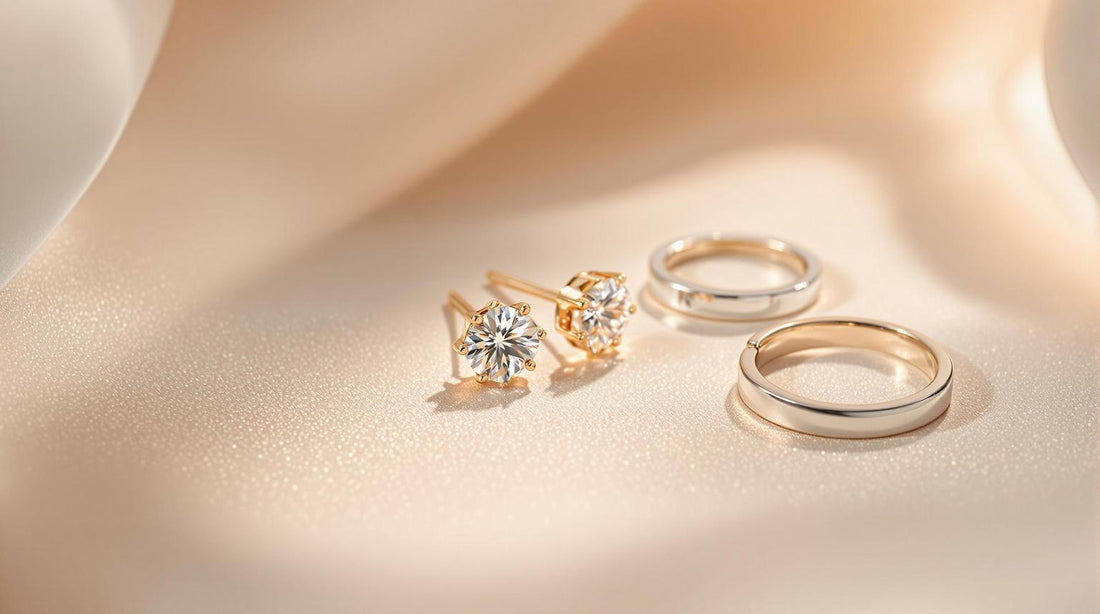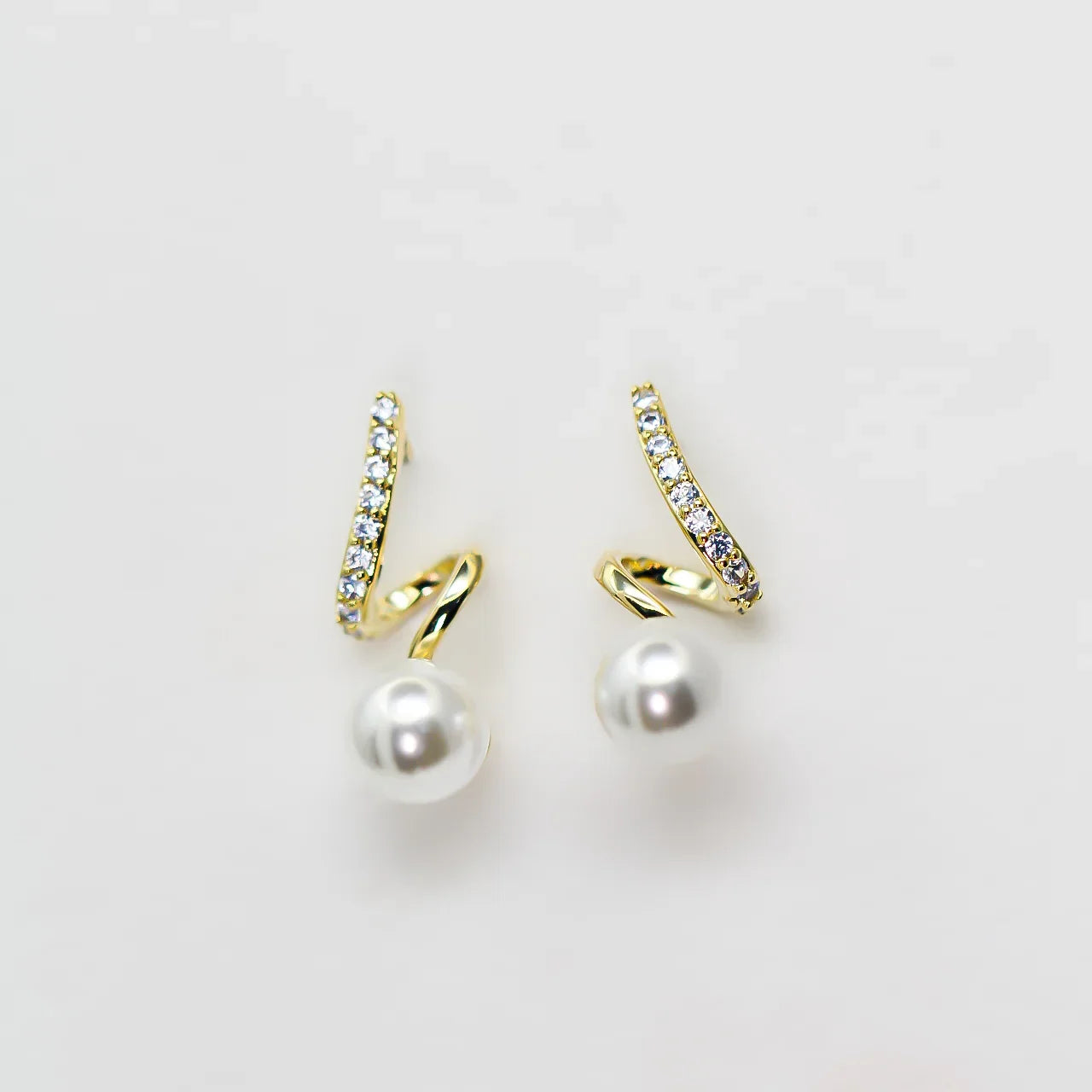
How to Choose Hypoallergenic Earrings: A Guide for Sensitive Skin
Share
If earrings often cause redness or swelling, you might have a metal allergy. About 1 in 5 adults experience this, with nickel being the top culprit behind 81% of reactions. Hypoallergenic earrings can help, but not all are created equal. Here’s what you need to know:
- Best Materials: Opt for medical-grade titanium, niobium, or 14k+ gold for safe, durable options. Avoid plated finishes and low-purity metals.
- Certifications to Look For: Check for ASTM F136 (implant-grade titanium) or ISO 10993 (biocompatibility) to ensure safety.
- What to Avoid: Steer clear of nickel, copper, and brass, as well as cheap plated jewelry that can wear down over time.
- Top Brands: Consider trusted names like Tini Lux (nickel-free titanium) or Amulya Gems (pure gold options).
Quick Comparison of Safe Materials
| Material | Safety Rating | Cost Range | Best For | Key Features |
|---|---|---|---|---|
| Medical Titanium | ★★★★★ | $22-60 | Daily wear | Lightweight, non-reactive |
| Niobium | ★★★★★ | $30-75 | Color variety | Durable, hypoallergenic |
| Platinum | ★★★★☆ | $200+ | Investment pieces | Long-lasting, pure |
| 14k+ Gold | ★★★★☆ | $80-300 | Special occasions | Classic, good longevity |
| Plastic (PTFE) | ★★★★☆ | $8-40 | Initial piercings | Metal-free |
To avoid irritation, always prioritize certified materials, clean your earrings regularly, and consult a dermatologist if reactions persist. Ready to dive into the details? Let’s explore the best hypoallergenic options and shopping tips.
10 Best Earrings for Sensitive Ears
Metal Allergies and Jewelry
Understanding which metals can cause allergic reactions and the differences in labeling can help you make better jewelry choices.
Metals That Commonly Cause Reactions
Nickel is a major culprit, responsible for 81% of allergic reactions, often appearing after more than a year of wear.
Here are some metals to watch out for when choosing jewelry:
| Metal | Common Symptoms |
|---|---|
| Nickel | Redness, blisters |
| Copper | Green discoloration |
| Brass | Swelling |
Hypoallergenic vs. Nickel-Free: What You Need to Know
The terms "hypoallergenic" and "nickel-free" are not the same. Under industry guidelines, hypoallergenic jewelry can still release up to 0.2% nickel.
Durability also sets them apart. Nickel-free jewelry tends to last longer because it's made from materials that are safe by design. In contrast, hypoallergenic earrings with nickel coatings often fail, with 43% losing their protective layer within two years.
If you already know you have a metal allergy, it's a good idea to consult a dermatologist for testing before buying multiple pieces. Allergy tests have a 92% success rate in confirming nickel sensitivity, giving you the information you need to select jewelry that works for you.
Best Materials for Sensitive Skin
Choosing the right metal for sensitive ears means focusing on materials that minimize allergic reactions. Research highlights several metals that are consistently well-tolerated by individuals with sensitivities.
Safe Metal Options
When it comes to safety and style, these materials are top choices:
Medical-Grade Titanium is widely recognized as one of the safest options. With less than 0.05% nickel content, it's ideal for sensitive skin. Though slightly more expensive ($22-60 for studs), titanium is also lightweight - 45% lighter than steel.
Niobium is another great pick for sensitive ears. This metal is non-reactive and maintains its hypoallergenic properties over time, unlike plated alternatives. Its versatility and durability make it a favorite.
Pure Precious Metals, such as platinum and 14k+ gold, are safe choices when used at higher purities (18k or more). However, white gold below 10k often contains nickel alloys, which caused reactions in 78% of cases studied.
"ASTM F136 titanium is the global standard for medical implants because it integrates with human tissue without immune response." - Simply Whispers Product Guide
For a completely metal-free option, PTFE-coated hooks are a smart choice. Dermatologists often recommend these for preventing irritation, and products like Rogers Jewelry Co.'s PTFE sleepers are designed for comfortable nighttime wear.
Materials at a Glance
Here's a quick comparison of hypoallergenic materials:
| Material | Safety Rating | Average Cost | Best For | Notable Features |
|---|---|---|---|---|
| Medical Titanium | ★★★★★ | $22-60 | Daily wear | Lightweight, non-reactive |
| Niobium | ★★★★★ | $30-75 | Color variety | Durable, easy to anodize |
| Platinum | ★★★★☆ | $200+ | Investment pieces | Long-lasting, naturally pure |
| 14k+ Gold | ★★★★☆ | $80-300 | Special occasions | Classic look, good longevity |
| Plastic | ★★★★☆ | $8-40 | Initial piercing | Completely metal-free |
These materials are compatible with all earring styles, from simple studs to elegant hoops.
Brands like Bondeye Jewelry have seen success with rhodium-plated pieces, which resolved lobe dermatitis in 89% of users within four weeks. Similarly, Galleria Armadoro backs their products with material certificates showing nickel content under 0.01%.
For care, clean titanium and steel with alcohol wipes, and store silver in anti-tarnish bags to prevent oxidation.
sbb-itb-1e688ee
Smart Shopping Tips
Shopping for hypoallergenic earrings means paying close attention to materials and certifications. Once you've got the basics of materials down, it's time to focus on how to verify their safety.
Safety Certifications
Certifications are your best friend when it comes to confirming material purity. Here are two key standards to look out for:
| Certification | Standard | What It Ensures |
|---|---|---|
| ASTM F136 | Implant-grade titanium | Less than 0.05% nickel content |
| ISO 10993 | Biocompatibility testing | Confirms materials are non-toxic |
"Hypoallergenic means 'below normal' allergenic - not non-allergenic. True safety requires medical-grade certifications." - Tini Lux Materials Guide
What to Avoid
Some features in earrings can increase the risk of an allergic reaction. Here’s what you should steer clear of:
- Plated finishes: These can wear off and expose allergenic metals. Stick to solid metals instead.
- Cheap post materials: Always ask for a full breakdown of the metal composition.
- Hollow backs/posts: These can trap bacteria and irritate sensitive skin.
Top Brands for Sensitive Skin
Some brands excel at creating earrings that are both safe and stylish, without compromising on material quality:
- Tini Lux: Offers niobium earrings starting at $35, paired with ASTM F136 titanium posts. Clinical studies show a 98% non-reactivity rate over five years.
- Amulya Gems: Specializes in pure 14k and 18k gold pieces, priced between $150 and $500. They provide lifetime warranties against allergic reactions and include detailed material composition reports with every purchase.
Investing in certified, medical-grade earrings might cost more upfront, but they’re worth it to avoid allergic reactions - especially if you have new piercings or sensitive skin.
Style Guide for Sensitive Ears
Finding earrings that combine style and comfort can be a challenge for those with sensitive skin. The key is choosing designs that look great while being gentle on your ears.
Best Earring Styles
When it comes to earrings for sensitive ears, both material and design play a crucial role. Lightweight options, ideally under 5 grams, are perfect for all-day comfort. Here are some great choices based on piercing types:
| Style | Features That Work | Suggested Design |
|---|---|---|
| Studs | Flat-back closure, small size (2-3mm) | Threadless titanium studs |
| Hoops | Small diameter (4-8mm), secure clasp | Solid gold huggies |
| Dangles | Simple, minimal components | Niobium drop designs with fewer joints |
For dependable options, look for brands that focus on certified materials. For example, Urban Body Jewelry offers ASTM F2923-certified titanium studs that are both stylish and safe.
Office to Evening Looks
Transitioning your look from work to a night out doesn’t have to sacrifice comfort. Simply Whispers offers a clever system that allows you to transform daytime studs into evening-ready earrings. Their convertible titanium designs let you swap 4mm crystal tops for 18mm pearl drops, making them perfect for any occasion.
Here are a few suggestions for professional and evening wear:
- Daytime: Rhodium-plated titanium lotus teardrop earrings, measuring a subtle 12mm.
- Evening: Minimalist medical-grade plastic studs for a sleek look.
To keep your ears happy and stylish, follow these tips:
- Use silicone backs instead of metal to distribute pressure more evenly.
- Limit decorative earrings to 8-hour wear for added comfort.
- Opt for solid 14k gold posts for those extra-special occasions.
If versatility is a priority, consider investing in convertible systems. These systems, like the Cynthia Rowley collection, feature titanium bases with snap-on embellishments, allowing you to adapt your look throughout the day.
Summary and Next Steps
Now that you’re familiar with material options and certification standards, it’s time to put this knowledge into practice. Here’s how to choose earrings that prioritize both safety and style:
Your Action Plan:
- Check your current jewelry: Use detection kits to identify any problematic materials.
- Choose certified materials: Look for ASTM or ISO certifications to ensure safety.
- Seek professional advice: If issues persist, consult a dermatologist for guidance.
Brands like Blomdahl USA and Tini Lux offer certified options for various budgets. Blomdahl USA specializes in medical-grade titanium, backed by clinical safety data, while Tini Lux features surgical steel earrings starting at just $12 per pair.
Stay Informed with Trusted Resources:
- The FDA’s guidelines on jewelry materials
- The SkinSAFE allergy certification database, endorsed by the Mayo Clinic
- The Association of Professional Piercers (APP) certified studios directory
If irritation continues, consider a patch test as discussed in the Metal Allergies section. Clinical studies reveal that 62% of reactions are caused by bacterial buildup, not metal allergies. This highlights the importance of regular cleaning and maintenance for long-term comfort.
FAQs
What is the best metal for sensitive ears earrings?
For sensitive ears, medical-grade titanium (ASTM F136) and niobium are the top recommendations due to their 0% nickel content.
"While stainless steel is popular, our clinical studies show 18% of users still develop reactions within 6 months of continuous wear".
This matches earlier findings that 43% of coated earrings fail within two years. If your ears are extremely sensitive, consider options like PTFE-coated materials or glass, as mentioned in the Materials Guide.
When shopping, always look for ASTM or ISO certifications discussed earlier. For specific brand suggestions and certification details, check the Smart Shopping Tips section.

